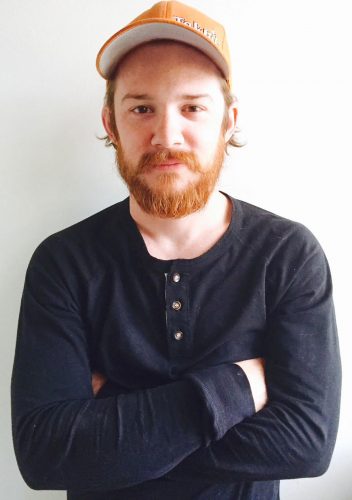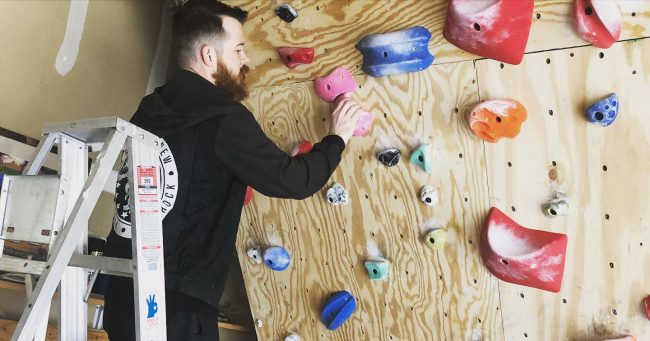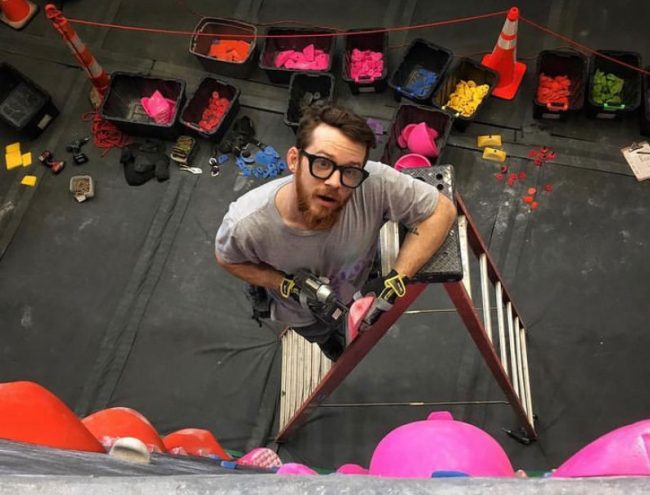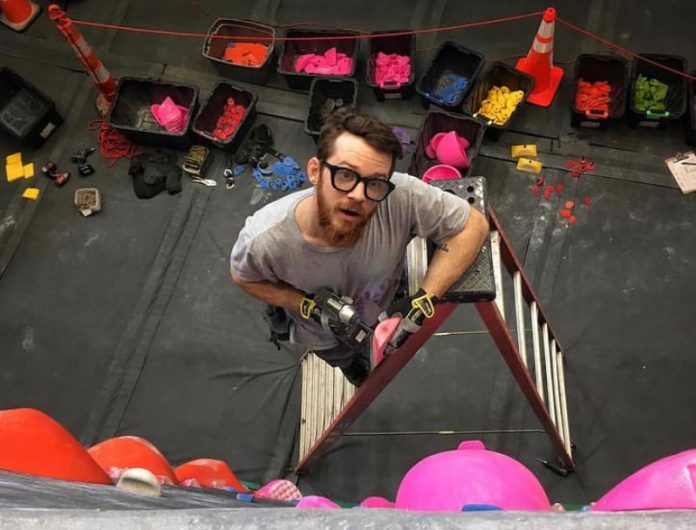Behind the Wrench…is an ongoing series that interviews the “rock stars” of the climbing industry: the routesetters at the gyms. This time CBJ heads to South Carolina for a virtual visit to a gym—BlocHaven—that is just getting off the ground and planning a grand opening for this spring. The gym has already hired a head routesetter and the preparation is reaching an apex. Naturally, we were interested in hearing all about it.

Name: Aaron Davis
Title: Head Routsetter, BlocHaven
Location: Greenville, South Carolina
CBJ: BlocHaven is a new gym…does this mean you are new to routesetting, or have you had some experience setting at other facilities?
DAVIS: I wouldn’t say new, though I am always learning—but I’ve been setting consistently in two different gyms and various competitions around the country over the last 13 years. However, BlocHaven is a brand new gym that will be one of the largest bouldering gyms in the southeast and will be my first bouldering gym, so I’m very excited about that.
What’s the vibe like in Greenville [South Carolina], both for indoor climbing and for routesetting? Or, another way of phrasing, is there much of a community of routesetters there?
The best way I can describe Greenville is small town vibes with big-city amenities and maybe the largest selection of homewalls I’ve seen in a city this size [laughs]. It’s growing quite fast and is more than ready for a modern gym. There is a sizable existing climbing community that I’m looking forward to serving and helping to grow that was really forged through our predecessors in the area. Unfortunately, there hasn’t been a large indoor climbing scene in South Carolina, in general, and while there’s not a large community of routesetters in this direct area—yet—there are some who have really helped carry the community forward in the last ten years. Needless to say, everyone here is ecstatic about this facility.

If you were giving a sales pitch, why should more routesetters head to Greenville?
Well, if you’re looking for a small growing city with big-city amenities and a strong climbing community, then Greenville may be your spot. It’s relatively close to a wide array of climbing, plus a routesetting program [at BlocHaven] that includes:
- Providing accessibility to all stages of climbers; Developing our climbing to be diverse and offer a variety of styles at all difficulty levels.
- Utilizing our comp wall to host competitions and camps, teach clinics, provide our competitive youth team with regular comp simulations, etc.
- Allowing for more customer engagement
- A healthy life/work/climb balance
- Space for experimenting and growth
- Encouragement and provision for professional development
Let’s get into some routesetting nuance. What’s in your routesetting tool belt?
My belt is pretty simple…and padded. I do love carrying a few extra screw-on jibs and my limited edition Scott Jones T-wrench that has been with me for years. Otherwise, I carry your typical bits, screws, markers, and probably some chips and salsa [for snacking] most days.
We’ve been hearing for a number of years that the big trend in routesetting…particularly in competitions, but also trickling down to some gyms…is more dynamic routes…the “parkour-style,” etc. But I’d like to know if you’ve detected any subtler trends. Like, what’s different or trendy in routesetting this year that wasn’t trendy three or four years ago?
To me, dynamic movement has always been a feature of climbing, but certainly it is more popular now and can be really fun to watch. The difference in the last couple of years that I’ve seen—and am personally loving—is that the movement is more involved than the traditional “jump” or “paddle.” We’re seeing intricate, coordinated static and dynamic movement in ways we may not have seen before…unless, of course, you’ve climbed at Font. The climbers at the highest levels continue to get better in all aspects and so…more is being asked of them. The routesetters must challenge them in various ways in order to separate and bring about the best climber at an event.
Speaking of setting intricate movements and whatnot, as a head routesetter for a new gym, you’ll undoubtedly be in charge of hiring and teaching some new routesetters at some point. How do you go about teaching routesetting in this day and age?
In my opinion, there’s so much more that goes on behind the scenes to routesetting than just bolting holds on a wall, and I think it’s very important for someone interested in routesetting to learn those aspects first. Rope/ladder management, stripping routes, washing holds, fixing t-nuts, forerunning, fundamentals of movement…just to name a few. When I start teaching a prospective routesetter, I focus on those basics first because they establish a foundation of understanding and competence. I think it builds confidence for a new routesetter to have that groundwork under them, so that when we get to the actual “bolting holds to the wall” part, we can really focus on the intricacies of movement and be more efficient. From there, I typically like to have assignments with specific goals for a routesetter “trainee,” to give them a direction and target to aim for. I find it helps to jumpstart the process.
In your experience, what has been the hardest routesetting concept for new routesetters to grasp?
Letting go of a sequence. Sometimes things just don’t go the way we intended, and that’s OK. Letting go and embracing a different idea or concept can often lead to the best climbs.

To that point, how do you get trainees to successfully grasp the idea of letting go of ideas?
I think most routesetters have experienced this phase in one form or another; I know I have…and in my experience, there’s really two ways that typically work together to help a routesetter grasp this concept. One, the most important for me, is positive, constructive communication from a senior routesetter that explains why this sequence or move is not working. Two is patience and room for the prospective routesetter to make those mistakes—and for them to visibly see them pan out. I have been fortunate enough to have worked with a number of more seasoned routesetters who have afforded me that patience and allowed me to make stubborn mistakes.
Finally, describe the next route you’re going to set. What will make it cool?
The next route I’m going to put up will be when I begin the initial set in a few weeks and I’m aiming for a “Finals” quality VB. Hopefully it will give new climbers the fun and challenging experience that we climbers seek regularly.

John Burgman is the author of High Drama, a book that chronicles the history of American competition climbing. He is a Fulbright journalism grant recipient and a former magazine editor. He holds a master’s degree from New York University and bachelor’s degree from Miami University. In addition to writing, he coaches a youth bouldering team. Follow him on Twitter @John_Burgman and Instagram @jbclimbs. Read our interview Meet John Burgman, U.S. Comp Climbing’s Top Journalist.









